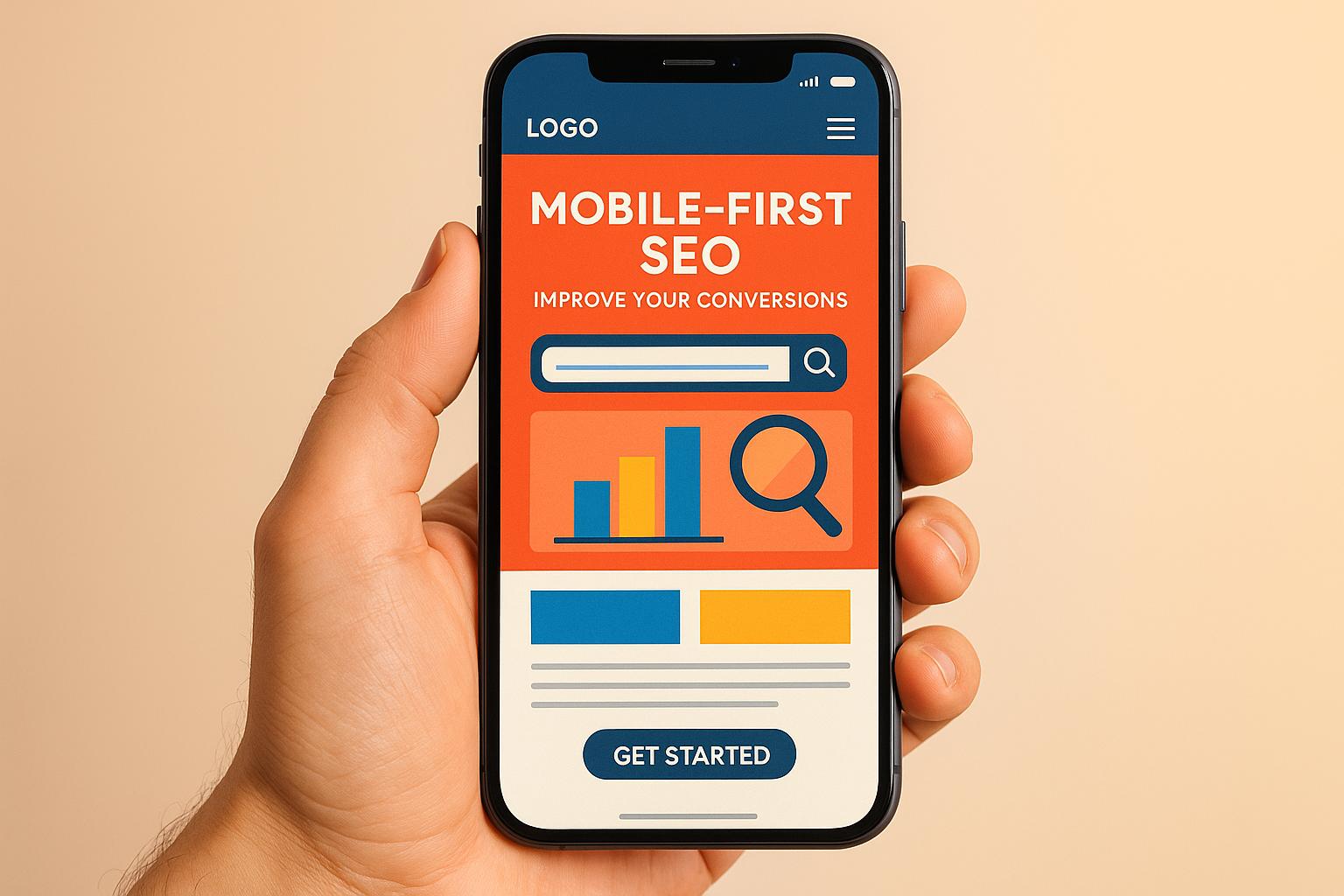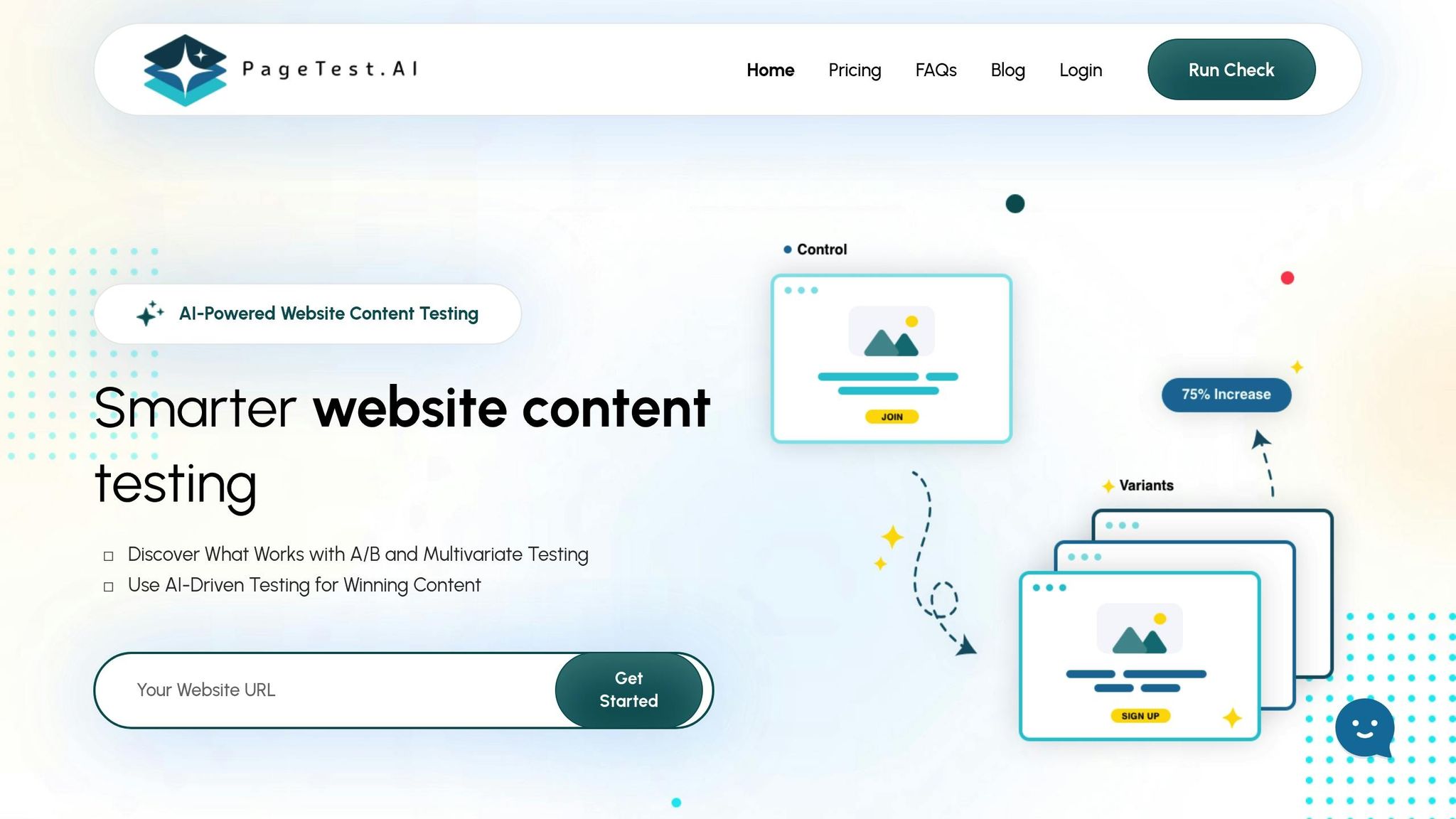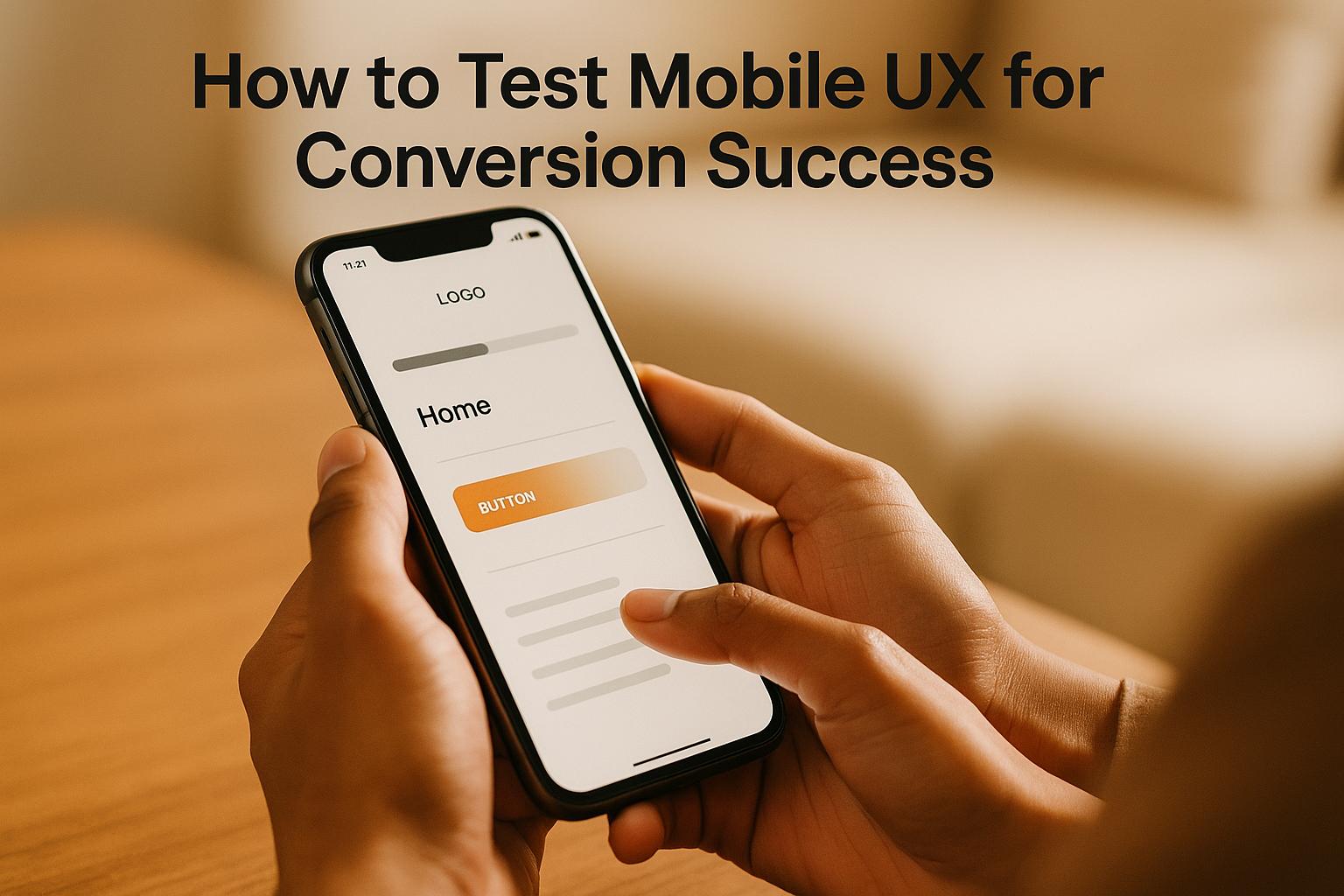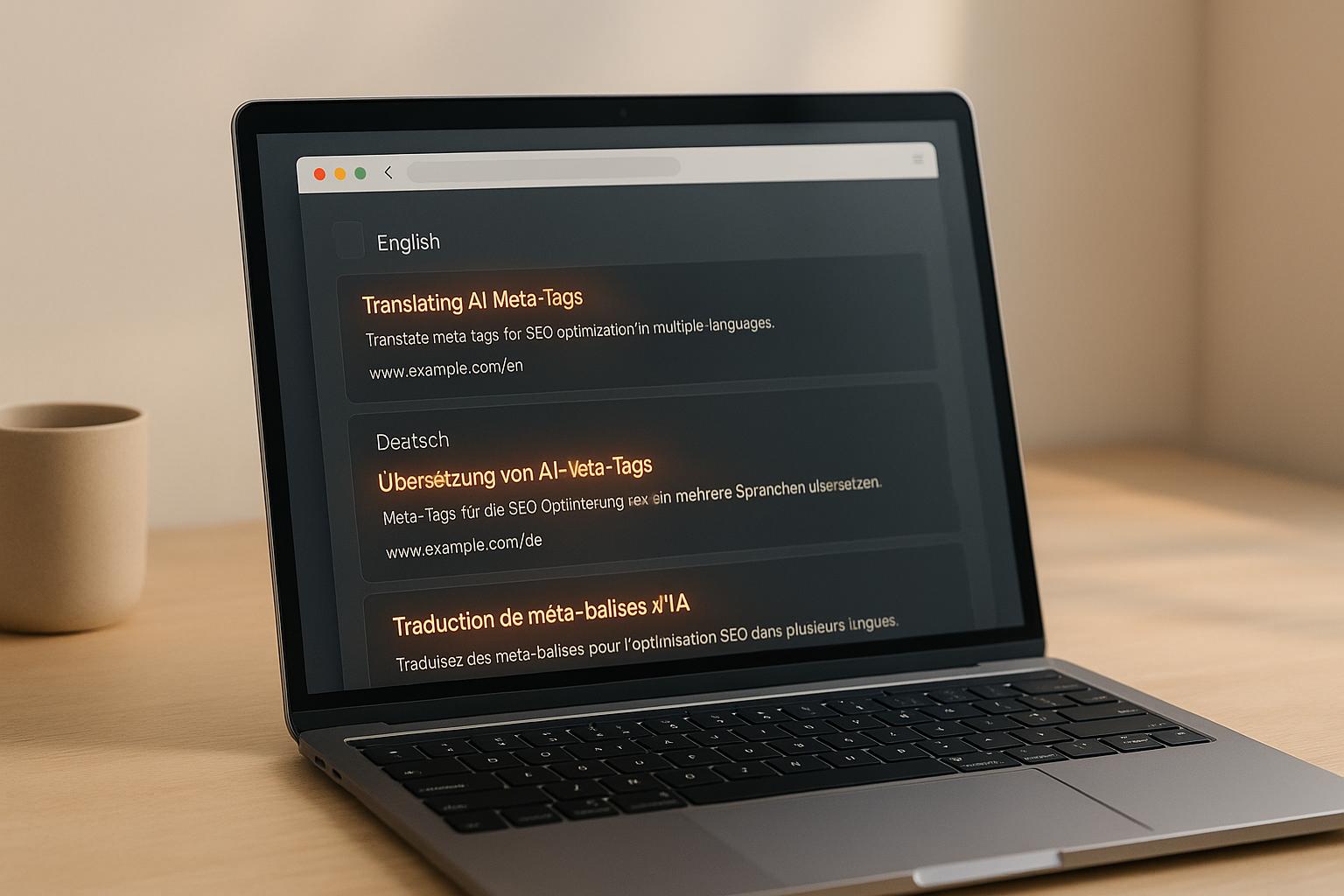

How Mobile-First SEO Impacts Conversions

How Mobile-First SEO Impacts Conversions
 20-11-2025 (Last modified: 20-11-2025)
20-11-2025 (Last modified: 20-11-2025)
Mobile-first SEO focuses on optimizing your website for mobile users, which is critical since mobile devices now drive the majority of web traffic. By prioritizing mobile usability, businesses can significantly improve user experience and conversion rates. Here’s why it matters:
- Mobile accounts for 64% of web traffic by 2025. Google uses mobile-first indexing, evaluating your site’s mobile version for search rankings.
- Speed drives conversions. A 1-second improvement in load time can boost conversions by up to 10.1% for industries like retail and travel.
- Frustration kills engagement. 53% of users leave if a site takes over 3 seconds to load, and slow pages can reduce conversions by 20%.
- Mobile-friendly design matters. Clear navigation, touch-friendly buttons, and fast-loading pages reduce bounce rates and increase engagement.
Key strategies include optimizing page speed, simplifying navigation, and designing effective mobile CTAs. Use tools like PageTest.AI to test and refine your mobile site without coding, helping you track metrics like bounce rates, clicks, and conversions. Businesses that prioritize mobile optimization see higher engagement and revenue growth.
Your Mobile Site is KILLING Your Conversion Rate
How Mobile-First SEO Increases Conversions
Mobile-first SEO paves the way for higher conversion rates by improving how users interact with your website. When your site is designed with mobile users in mind, you cater to the majority of your audience, making it easier for them to take meaningful actions.
This approach ties into the broader mobile-first philosophy, which emphasizes user needs and smooth conversion processes.
Better User Experience Through Mobile-First SEO
The link between mobile optimization and higher conversions starts with creating a seamless user experience. Mobile-first SEO ensures your site loads quickly, looks sharp on smaller screens, and offers navigation that’s easy to use with touch gestures.
Fast-loading pages and responsive layouts keep visitors engaged while maintaining a professional appearance across devices.
Mobile-first design also focuses on touch-friendly functionality. Buttons are sized for easy tapping, forms are simplified for quick input, and navigation menus are designed for effortless scrolling and selection. By removing obstacles that might discourage mobile users from completing purchases or filling out forms, you create a more user-friendly experience.
On mobile devices, where screen space is limited, prioritizing key content and calls-to-action (CTAs) is crucial. Mobile-first SEO helps users find what they need faster, naturally leading to higher conversion rates.
This improved user experience also reduces bounce rates, as explained in the next section.
How Mobile-First Design Lowers Bounce Rates
A seamless design eliminates common frustrations like slow load times, hard-to-use navigation, and poorly displayed content – issues that often drive users away.
Mobile-first design solves these problems by offering intuitive navigation and well-organized content. When users can easily browse pages and consume information presented with clear fonts and proper spacing, they’re more likely to stay on your site and engage further.
Additionally, providing a frustration-free experience helps build trust in your brand. A positive first impression increases the chances that a visitor will complete a desired action, such as making a purchase, or return later to do so.
Data That Proves Mobile SEO Boosts Conversions
The benefits of mobile-first SEO are backed by compelling data. For example, improving mobile site speed by just 0.1 seconds can increase conversion rates by 8.4% for retail businesses and 10.1% for travel companies. Even small speed enhancements can dramatically impact performance.
A site that loads in 1 second achieves an e-commerce conversion rate 2.5 times higher than one that takes 5 seconds to load.
Real-world examples underscore these advantages. Retailers and travel companies have reported significant sales growth and fewer abandoned carts after adopting mobile-first strategies. Businesses implementing this approach have seen up to a 30% boost in engagement and conversions. Furthermore, 80% of top-ranking sites are optimized for mobile, showcasing the competitive edge that mobile-first SEO provides.
These statistics make it clear: mobile-first SEO isn’t just about keeping up with user behavior – it’s a powerful way to drive conversions and grow your business.
Key Elements of Mobile-First SEO That Drive Conversions
To truly succeed in mobile-first SEO, there are certain key elements that can make all the difference. These elements are designed to create a seamless experience for mobile users, helping them navigate effortlessly, stay engaged, and complete their desired actions. Let’s break down the steps that can elevate your mobile strategy and boost conversions.
Mobile Page Speed Optimization
When it comes to mobile users, speed is everything. A page that takes even a second too long to load can lead to frustrated users and lost opportunities. Faster load times mean fewer drop-offs and more chances to convert visitors into customers.
To achieve this, focus on optimizing images, reducing unnecessary code, enabling caching, and leveraging CDNs (Content Delivery Networks). Tools like Google PageSpeed Insights and Lighthouse are excellent for pinpointing areas that need improvement. For businesses interested in testing these changes, platforms like PageTest.AI allow you to run A/B tests on mobile content while tracking performance metrics to see what works best.
Simple Navigation and Mobile CTAs
Speed alone isn’t enough – users also need an intuitive path to find what they’re looking for. Mobile screens require a different approach to navigation and call-to-action (CTA) design compared to desktops. Simplified menus and a prominent search function help users locate information quickly and easily.
For CTAs, make sure buttons are large enough to tap without frustration and use contrasting colors so they stand out. Place CTAs strategically, such as above the fold or at the end of key sections, to capture attention at just the right moment. The wording should be direct and action-focused – phrases like "Buy Now", "Call Today", or "Get Free Quote" guide users toward their next step. Tools like PageTest.AI can also help you test different CTA designs and placements to find the most effective combinations.
Content Consistency and Mobile Features
Consistency is key when it comes to content. Ensuring that your text, images, and structured data align across both desktop and mobile platforms not only improves SEO but also builds trust with your audience. When users see the same content, no matter the device, it creates a seamless and reliable experience.
But don’t stop at just mirroring desktop content. Mobile-specific features can take user engagement to the next level. For example, GPS integration allows businesses to offer location-based deals, like showing the nearest store or highlighting local promotions. Click-to-call buttons make it easy for users to contact you directly, while camera integration can support features like QR code scanning or product customization.
| Element | Key Benefits | Implementation Focus |
|---|---|---|
| Mobile Page Speed | 8.4–10.1% boost in conversions per 0.1s gain | Image compression, code reduction, CDNs |
| Simple Navigation & CTAs | 15–30% higher conversion rates | User-friendly menus, bold and clear CTA design |
| Content Consistency | Higher SEO rankings and user trust | Uniform content, mobile-specific enhancements |
sbb-itb-6e49fcd
AI Tools for Mobile Conversion Optimization
Optimizing mobile conversions can feel overwhelming, especially with the need to test headlines, CTAs, and product descriptions across various devices. Traditionally, this process demanded technical expertise and significant time. However, AI-powered platforms have transformed the game, making testing simpler and accessible to businesses of all sizes – no coding required.
These tools analyze user behavior, automatically create content variations, and offer insights based on real conversion data. This not only speeds up the optimization process but also ensures measurable results. Platforms like PageTest.AI are leading this shift, simplifying mobile optimization for marketers.
How PageTest.AI Simplifies Mobile Testing

With PageTest.AI, mobile optimization becomes as easy as point-and-click. Using a Chrome extension, users can highlight any element on their mobile site – be it a headline, CTA button, product description, or navigation text – and instantly set up tests without needing to write a single line of code.
The platform’s AI engine generates multiple content variations based on proven performance data, removing the guesswork. For example, it might suggest different CTA designs while tweaking button sizes and colors to improve usability on mobile devices. It even considers touch-friendly layouts and typical mobile user behavior.
Here’s how it works:
- Highlight the content element you want to optimize.
- Let the AI create variations.
- Monitor real-time performance.
This streamlined process eliminates the technical hurdles that often prevent businesses from conducting thorough mobile tests, making it accessible even to teams with limited technical expertise.
Monitoring Mobile Conversion Data
To understand what drives mobile conversions, tracking the right metrics is crucial. PageTest.AI monitors key indicators like clicks, engagement, time spent on a page, and scroll depth to pinpoint which content elements and CTAs resonate with users.
But it doesn’t stop at surface-level metrics. The platform also analyzes broader user journeys, tracking multi-step interactions. For instance, it identifies whether users navigate to additional pages, fill out forms, or complete other actions after engaging with the tested content.
"Love this product, it means we get the most from our site’s traffic. Knowing we can test every call to action and optimize our SEO efforts is very satisfying." – David Hall, CEO, AppInstitute
This deep level of tracking helps businesses see the bigger picture, going beyond immediate click-through rates to understand the overall impact of their optimizations.
Platform Integration and Growth Options
PageTest.AI works seamlessly with popular website platforms like WordPress, Wix, Google Tag Manager, Shopify, and Magento. All it takes is adding a simple code snippet, making integration straightforward regardless of your existing tech stack.
The platform also scales with your business, offering flexible pricing plans to meet different needs:
- Trial Plan: Free, includes 10,000 test impressions, five pages, and five tests for one website – ideal for testing the platform.
- Startup Plan: $10/month, includes 10,000 test impressions, 10 pages, and 10 tests for one website – perfect for small businesses.
- Enterprise Plan: $50/month, includes 100,000 test impressions, 100 pages, and 100 tests for up to 10 websites – suited for growing companies.
- Agency Plan: $200/month, includes 1,000,000 test impressions and unlimited pages/tests across 100 websites – designed for marketing agencies.
| Plan | Monthly Cost | Test Impressions | Pages/Tests | Websites | Best For |
|---|---|---|---|---|---|
| Trial | $0 | 10,000 | 5 pages, 5 tests | 1 | Testing the platform |
| Startup | $10 | 10,000 | 10 pages, 10 tests | 1 | Small businesses |
| Enterprise | $50 | 100,000 | 100 pages, 100 tests | 10 | Growing companies |
| Agency | $200 | 1,000,000 | Unlimited | 100 | Marketing agencies |
This flexibility ensures businesses can continue optimizing as they grow, without needing to switch platforms or rebuild their testing setup. Plus, the AI becomes more effective over time, refining its recommendations as it processes more user data, ensuring consistent improvements in mobile conversion rates.
Tracking Results and Making Ongoing Improvements
Achieving success with mobile-first SEO isn’t a one-and-done task – it requires constant monitoring and fine-tuning. By keeping an eye on key metrics, you can identify what’s working, spot problem areas, and make adjustments to improve performance. Let’s dive into the most important metrics and how to use them effectively.
Key Metrics for Mobile Optimization
Mobile conversion rates are your ultimate measure of success. They show how well your mobile site turns visitors into customers or leads. Even small tweaks here can lead to big gains.
Bounce rates on mobile are another critical metric. High bounce rates often point to user experience issues, such as slow load times or confusing navigation. Research shows that sites taking over three seconds to load see a sharp increase in abandonment rates. Aim to keep your mobile bounce rate below 50%.
Mobile page speed has a direct impact on your bottom line. A tiny improvement – just 0.1 seconds – can boost conversion rates by 8.4% for retail and 10.1% for travel sites. Tools like Google PageSpeed Insights can help you identify and address slow-loading elements on your site.
Engagement metrics like average session duration, pages per session, and click-through rates on mobile calls-to-action (CTAs) provide a window into how users interact with your site. Low engagement might mean your CTAs aren’t clear, your content isn’t hitting the mark, or your navigation needs work.
Time on page and scroll depth offer clues about how much of your content users are consuming. These metrics can help you pinpoint which pages are grabbing attention and which might need better formatting or more compelling content.
| Metric | Industry Benchmark | What It Indicates | Action Threshold |
|---|---|---|---|
| Mobile Load Time | Under 3 seconds | Site performance and user patience | Over 3 seconds needs immediate action |
| Bounce Rate | Below 50% | User engagement and content value | Above 60% signals UX issues |
| Conversion Rate | Varies by industry | Mobile funnel effectiveness | Any drop requires investigation |
| Session Duration | 2+ minutes | Content quality and user interest | Under 1 minute suggests content issues |
Continuous Testing for Better Results
Monitoring metrics is just the beginning. To truly improve your mobile performance, you need to test and refine based on what the data tells you.
A/B and multivariate testing are powerful tools for experimenting with different elements of your site. Test things like CTA button placement, headline wording, form lengths, image sizes, and navigation layouts. Each test gives you valuable insights into what resonates most with your users.
Platforms like PageTest.AI make testing easier by tracking metrics such as clicks, engagement, time on page, and scroll depth. This tool maps out the entire user journey, helping you understand not just what users click on, but how they interact with your site as a whole.
The secret to effective testing is acting on the results. When a test shows a winning change – whether it’s a new headline or a faster-loading page – roll it out across your site. If a change doesn’t perform well, don’t hesitate to roll it back. This iterative process ensures your site keeps evolving to meet user needs.
Rather than overhauling your entire site at once, focus on small, incremental improvements. Speeding up load times, refining navigation, or tweaking content might seem minor, but these small changes add up over time, significantly boosting your mobile conversion rates.
As mobile technology and user behavior continue to evolve, staying committed to regular monitoring and testing is essential. AI-powered tools can help simplify this process, but the key lies in creating a feedback loop: analyze your metrics, test new ideas, and implement what works. This cycle of continuous improvement ensures your mobile-first SEO strategy stays effective no matter how the landscape changes.
Conclusion: Mobile-First SEO for Better Conversions
Focusing on mobile-first SEO has become a necessity for businesses aiming to drive conversions. With mobile devices expected to account for 64% of web traffic by 2025, neglecting mobile optimization means potentially losing out on a significant share of your audience. And the numbers don’t lie – mobile-friendly sites deliver stronger performance.
For instance, websites that load in just 1 second boast e-commerce conversion rates 2.5 times higher than those taking 5 seconds to load. On top of that, Google’s mobile-first indexing prioritizes the mobile version of your site when determining rankings. This dual advantage – better visibility in search and improved conversion potential – makes mobile optimization a win-win.
Of course, implementing mobile optimization can feel overwhelming, especially with its technical demands. That’s where tools like PageTest.AI come in. By offering a no-code solution, it simplifies mobile testing and tracks essential metrics like clicks, engagement, time on page, and scroll depth. These insights allow you to make smarter, data-driven changes that directly impact your revenue.
The best part? Mobile optimization is within reach for everyone. Whether you’re running a small online store or juggling multiple websites, platforms like PageTest.AI make it easier to fine-tune your mobile experience – no heavy development work required.
As mobile technology advances and user expectations grow, businesses that prioritize continuous testing and improvement will stay ahead of the curve. The message is clear: mobile-first SEO isn’t just about staying relevant – it’s about driving real results. Start optimizing now, and you’ll see the benefits sooner than you think.
FAQs
How does mobile-first SEO enhance user experience and boost website conversion rates?
Mobile-first SEO focuses on making websites perform well on smartphones and tablets, which is essential since so many people now browse on the go. A mobile-friendly site isn’t just about looking good – it’s about working smoothly. Faster load times, easy navigation, and an overall seamless experience keep users engaged and less likely to bounce out of frustration.
This approach doesn’t just improve user experience; it can also boost conversion rates. When visitors can effortlessly find what they’re looking for, interact with a user-friendly design, and complete actions like purchases or form submissions without hiccups, they’re far more likely to take the next step. By putting mobile-first SEO at the center of your strategy, you’re setting your website up to meet the needs of today’s mobile-savvy audience.
How can I improve page speed for mobile devices to boost conversions?
Optimizing page speed on mobile devices is a game-changer for improving user experience and boosting conversions. Here’s how you can make it happen:
- Compress images and files: Shrink the size of media files using compression tools to maintain quality while reducing load times.
- Enable browser caching: Let returning visitors load your site faster by storing key elements locally on their devices.
- Minimize HTTP requests: Combine CSS, JavaScript, and HTML files to cut down on the number of server requests. Fewer requests mean quicker load times.
- Use a content delivery network (CDN): CDNs distribute your site’s content across multiple servers around the globe, ensuring users access the nearest server for faster loading.
- Focus on mobile-first design: Build a site that’s responsive, lightweight, and tailored for smaller screens, ensuring smooth browsing on mobile devices.
These steps not only align with mobile-first SEO principles but also pave the way for higher engagement and conversion rates. Tools like PageTest.AI can further fine-tune your site by testing and refining elements to create a seamless user experience.
How can businesses evaluate the effectiveness of their mobile-first SEO strategies?
To gauge how well your mobile-first SEO strategies are performing, focus on tracking key metrics such as click-through rates (CTR), user engagement, time spent on pages, and overall user behavior. These metrics provide valuable insights into how effectively your website meets the needs of mobile users and aligns with their search intentions.
Using performance analysis tools can make this process easier. These tools help you break down the data, allowing you to fine-tune your mobile content and boost conversion rates based on real user behavior.
Related Blog Posts
say hello to easy Content Testing
try PageTest.AI tool for free
Start making the most of your websites traffic and optimize your content and CTAs.
Related Posts

 18-11-2025
18-11-2025
 Ian Naylor
Ian Naylor
How to Test Mobile UX for Conversion Success
Enhancing mobile UX is crucial for boosting conversions. Explore effective strategies and testing methods to improve user experiences on mobile devices.

 17-11-2025
17-11-2025
 Ian Naylor
Ian Naylor
How AI Improves Mobile User Feedback Collection
Explore how AI transforms mobile user feedback collection, enhancing response rates and providing actionable insights for app developers.

 15-11-2025
15-11-2025
 Ian Naylor
Ian Naylor
Best Practices for AI Meta Tag Translation
Learn how AI-driven meta tag translation enhances multilingual SEO by improving engagement and search rankings through efficient localization.
